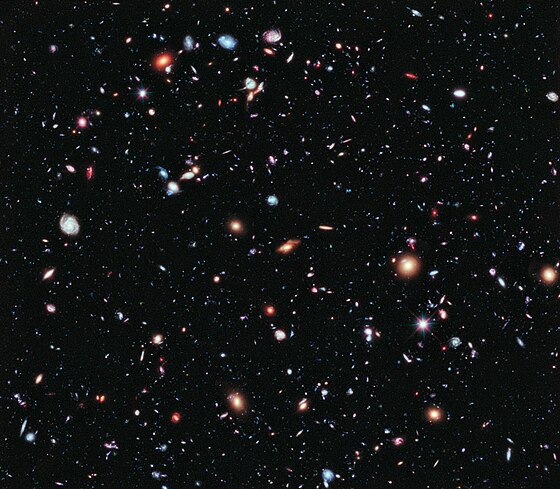
The Hubble eXtreme Deep Field.
(Image by Wikipedia (commons.wikimedia.org), Author: NASA, ESA, G. Illingworth, D. Magee, and P. Oesch (University of California, Santa Cruz), R. Bouwens (Leiden University), and the HUDF09 Team) Details Source DMCA
I spent decades of contemplation about the origin of the physical universe and the attributes of God.
I feel excited that Theology and Science published my (2020) paper "Theodicy, Supreme Providence, and Semiclassical Theism." The article focuses on my cosmological argument for the existence of God while I describe that the Supreme Being created the physical universe out of nothing and nonetheless never possesses the traditionally defined attribute of omnipotence.
Semiclassical theism describes that the attributes of God include inexhaustible perception and power while God's power never meticulously controls creation. Also, combining semiclassical theism with Trinitarianism implies that the divine attributes include inexhaustible love, perception, and power.
My (2020) paper also defines three categories of divine providence, that is, meticulous providence, semimeticulous providence, and supreme providence.
First, meticulous providence means that God always completely controls every event in the universe. Theologies of meticulous providence include Augustinianism, Thomism, Molinism, and Reformed.
Second, semimeticulous providence means that God can completely control every event in the universe while God strategically chooses what to control and what not to control. Theologies of semimeticulous providence include Eastern Orthodoxy, Arminianism, Methodism, most Charismatic Christianity, and standard open theism.
Third, supreme providence means that God cannot completely control the universe and God primarily intervenes in creation through synergy with created agents, such as humans. Theologies of supreme providence include Zoroastrianism, process theism, and semiclassical theism.
1. Semiclassical Cosmology
My cosmological argument implies that tensed phenomena had a foremost origin. And the Supreme Being who originally existed solely in tenseless eternity had created the first tensed phenomena out of nothing.
To clarify, I will define tensed phenomena and tenseless eternity. First, tensed phenomena occur in a region subject to tensed time, such as the physical universe. And tensed time is time that progresses from the tangible present to the future while the past and future are intangible. Alternatively, an entity existing in tenseless time exhibits no internal passage of time. For example, semiclassical theism proposes that God before creation was the entire universe and tenseless while nonetheless possessing the potential to create a tensed region and inhabit the tensed region. Also, God's original tenseless nature remained internally unchanged after the origin of creation.
Back to my cosmological argument. There might have been some type of tensed phenomena before the origin of quantum fields, but that is unknown while I focus on the origin of quantum fields.
For more background information, consider standard big bang cosmology, which is called lambda cold dark matter. It is based on the theoretical reversal of current observations documented in astrophysics and particle physics. Also, consider a simplified version of big bang cosmology that assumes a grand unified theory and the possibility for a theory of everything.
In this case, consider the first three epochs of big bang cosmology. The first quantum fields originated in the Planck Epoch when the universe was microscopic and the hottest possible temperature called the Planck temperature, which is 10^32 Kelvin (K). Also, the Planck temperature unified the four fundamental forces, that is, gravity, the strong force, the electromagnetic force, and the weak force. Next, the universe cooled into the Grand Unification Epoch while gravity separated from the other three fundamental forces that remained unified in the strong electroweak force. Then, the universe cooled into the Electroweak Epoch while the strong force separated from the electroweak force in a temperature between 10^27 and 10^15 K. Furthermore, the rapid expansion of space called cosmic inflation likely occurred during the Grand Unification Epoch or the Electroweak Epoch.
My argument concludes that the foremost creation of quantum fields was a fine-tuned quantum vacuum while a quantum vacuum has zero-point energy, which is the lowest possible energy of a quantum system. Furthermore, quantum field theory says that the quantum vacuum has a universal field for the fundamental forces, and actual particles and antiparticles are excited states of the vacuum.
Now, consider semiclassical cosmology and big bang cosmology. First, God created the universe's fine-tuned quantum vacuum out of nothing. Second, God generated a quantum fluctuation that originated the Planck Epoch or the Grand Unification Epoch while the Planck Epoch never actually existed.
(Note: You can view every article as one long page if you sign up as an Advocate Member, or higher).





